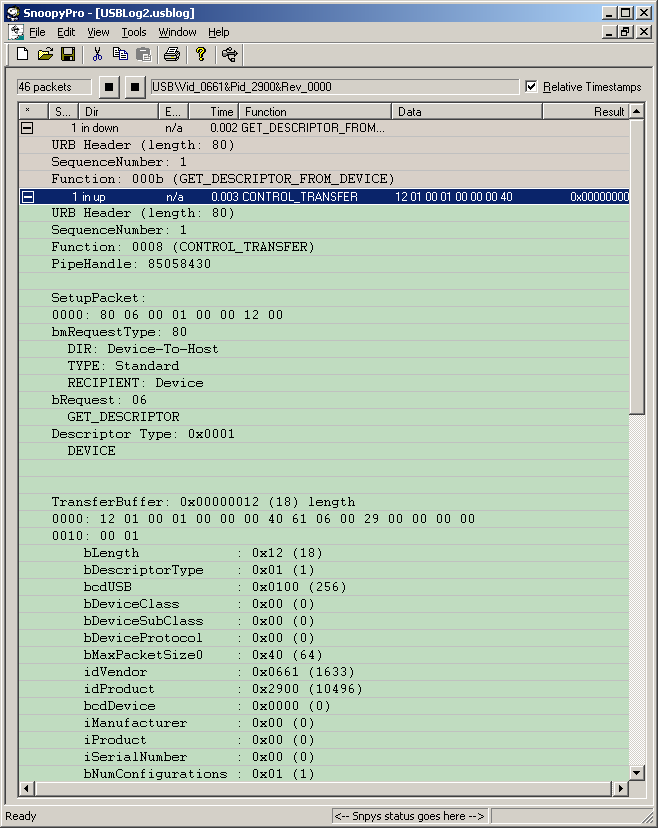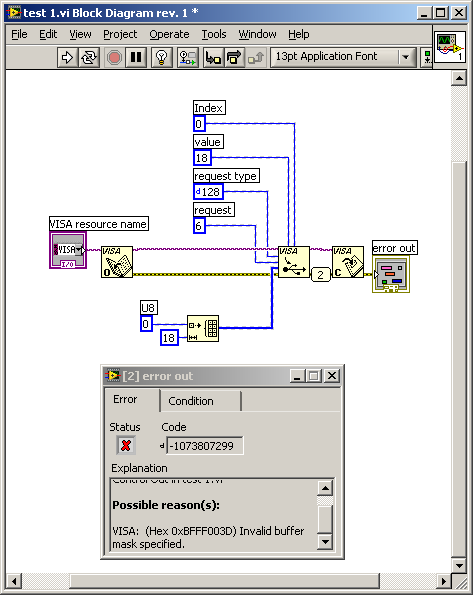- Subscribe to RSS Feed
- Mark Topic as New
- Mark Topic as Read
- Float this Topic for Current User
- Bookmark
- Subscribe
- Mute
- Printer Friendly Page
usb communication
10-18-2007 05:40 AM - edited 10-18-2007 05:40 AM
- Mark as New
- Bookmark
- Subscribe
- Mute
- Subscribe to RSS Feed
- Permalink
- Report to a Moderator
I'm using a device for which I already have device drivers and a DLL. This works fine. I am also able to interrogate the USB communication using SnoopyPro.
I have implemented the VISA driver using the VISA device driver wizard, and it seems to be up and running. I can also access the USB attributes programatically.
My problem is getting even the simple exchange in the picture to run in VISA. I have never programmed USB before, so I may be a bit lost.....

Can someone tell me how to implement this simple exchange in VISA. I know it requires using the "VISA USB Control out" and "VISA USB Control in" VIs, but I've no idea what to wire where.....
Thanks for every piece of helpful information, no matter how small.
Shane.
Message Edited by shoneill on 10-18-2007 12:40 PM
10-19-2007 04:50 AM
- Mark as New
- Bookmark
- Subscribe
- Mute
- Subscribe to RSS Feed
- Permalink
- Report to a Moderator
Hi shoneill,
If you have the driver dll for your device, why would you create a new one?
I would just call the functions in the dll to communicate with the instrument.
Creating your own usb driver requires deep knowledge about usb specs and standards.
Below a link to another discussion about creating your own usb driver.
What kind of device would you like to communicate with?
Evrem
10-19-2007 04:51 AM
- Mark as New
- Bookmark
- Subscribe
- Mute
- Subscribe to RSS Feed
- Permalink
- Report to a Moderator
10-19-2007 05:49 AM
- Mark as New
- Bookmark
- Subscribe
- Mute
- Subscribe to RSS Feed
- Permalink
- Report to a Moderator
It's not about the ability to use the device, it's about learning how to interface over USB...... I want to solve the problems because I want to learn how to use USB RAW communications.
As you have seen, I am able to capture the appropriate information when using the DLL driver. I want to be able to re-create this in LabVIEW to do away with the DLL.
I have since found trhe USB 2.0 specification and have printed what I think are the most applicable parts. I was unaware as to how complex USB communication can be, but I really want to be able to get this up and running.
If anyone has any clues (The values associated with certain standard commands would have been a good starting point - I've found these in the USB Spec eventually) I^m more than glad to hear them....
Shane.
10-19-2007 09:05 AM - edited 10-19-2007 09:05 AM
- Mark as New
- Bookmark
- Subscribe
- Mute
- Subscribe to RSS Feed
- Permalink
- Report to a Moderator

The USB sniffer program I have used does not give me the exact binary representation of the GET_DESCRIPTOR_FROM_DEVICE command, otherwise I could reverse-engineer the correct values quite easily...... Anyone help?
Message Edited by shoneill on 10-19-200704:06 PM
Message Edited by shoneill on 10-19-200704:06 PM
Message Edited by shoneill on 10-19-2007 04:07 PM
10-25-2007 09:01 AM
- Mark as New
- Bookmark
- Subscribe
- Mute
- Subscribe to RSS Feed
- Permalink
- Report to a Moderator
If I use the code posted previously, I see using my USB sniffer that a GET_DEVICE_DESCRIPTOR request is carried out (as intended), and responded to. The byte sequence (as much as the USB sniffer shows anyway) is identical to "normal" operation.
I also see that the DEVICE_DESCRIPTOR is only 4 bytes long (the third query since a USB reset). The returned values are also equal to those returned during "normal" operation, so I'm retrieving the right values.
Problem is, I still get the "Hex 0xBFFF003D) Invalid buffer mask specified" error at the "VISA USB Control Out". I can connect any length buffer to the Control out, or connect nothing at all, I still get the same error. Anyone have ANY idea what's going on here?
Shane.
02-05-2018 04:44 AM
- Mark as New
- Bookmark
- Subscribe
- Mute
- Subscribe to RSS Feed
- Permalink
- Report to a Moderator
Hi,
I do have the same problem. My Company needs to read every USB device independant to the operating system. Following that we need all the USB descriptors to start the connection and conversation with the different UUTs at the Teststation. If we do have all the descriptor data, connecting the UUTs isn't a problem. But we can't get our program to work to get the descriptors because of the same reasons.
Is there already a solution? Can sameone help?
Florian
